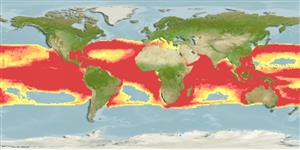Classification / Names
Common names from other countries
Main reference
Μέγεθος / Βάρος / Age
Max length : 488 cm TL αρσενικό/απροσδιόριστο; (Ref. 40637); common length : 350 cm TL αρσενικό/απροσδιόριστο; (Ref. 5217); μεγ. δημοσιευμένο βάρος: 363.8 kg (Ref. 40637); μεγ. αναφερόμενη ηλικία: 20 έτη (Ref. 28081)
Length at first maturity
Lm ?, range 154 - 341 cm
Περιβάλλον
; Θαλασσινό(ά); ωκεανόδρομο(ς) (Ref. 51243); εύρος βάθους 0 - 730 m (Ref. 89423), usually 0 - 100 m (Ref. 43278)
Κλίμα / Εύρος
Subtropical, preferred 27°C (Ref. 107945); 46°N - 40°S, 180°W - 180°E (Ref. 54278)
Κατανομή
Short description
Ραχιαίες άκανθες (συνολικά): 0; Μαλακές ραχιαίες ακτίνες (συνολικά): 0; Εδρικές άκανθες 0; Μαλακές εδρικές ακτίνες: 0. A large thresher with very large eyes, an indented forehead, a broad caudal tip, and curved broad-tipped pectoral fins; 1st dorsal fin further back than in other threshers (Ref. 5578). Upper lobe of caudal fin very long and strap-like almost or quite equal to length of rest of shark; lower lobe short but well developed (Ref. 13570). Purplish grey above, cream below, posterior edges of pectoral and pelvic fins and sometimes first dorsal fin dusky; light color of abdomen not expanded over pectoral-fin bases (Ref. 13570).
IUCN Red List Status (Ref. 115185)
Human uses
αλιεία: Εμπορικό(ά); αλιεία αναψυχής: ναί
Περισσότερες πληροφορίες
ΑναφορέςΥδατοκαλλιέργειεςΠροφίλ υδατοκαλλιέργειαςΣτελέχοιΓενετικήΣυχνότητες αλληλόμορφωνΚληρονομικότηταΑσθένειεςΜεταποίησηMass conversion
Εργαλεία
Special reports
Download XML
Διαδικτυακές πηγές
Estimates of some properties based on models
Phylogenetic diversity index
PD50 = 0.7500 many relatives (e.g. carps) 0.5 - 2.0 few relatives (e.g. lungfishes)
Τροφικό Επίπεδο
4.5 ±0.0 se; Based on diet studies.
Ελαστικότητα
Χαμηλό, ελάχιστος χρόνος για διπλασιασμό πληθυσμού 4,5 - 14 έτη (tm=7; K=0.088; Fec=2-4)
Vulnerability
Very high vulnerability (79 of 100)
Price category
